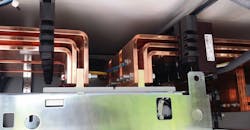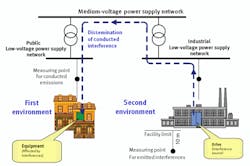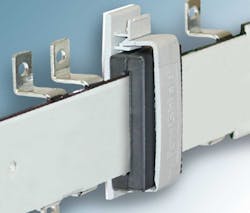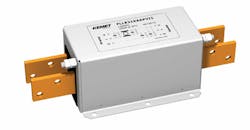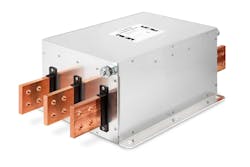This article is part of the TechXchange: Delving into EMI, EMC and Noise
Do busbars need EMI filters?
Yes, they do. Just because they’re large imposing structures, they can cause interference in other systems if you don’t measure the EMI and take steps to get it under legal limits. In some cases, you might want to reduce EMI even further than the legal requirement to make a quiet electrical environment for your sensors or control system.
EMI noise is created by any fast-changing currents, often represented by the calculus term di/dt, that is, the change of current over time. Fast-changing currents have high di/dt. If those currents are in a loop, that makes a great antenna, and it will radiate noise into your system and beyond. That same loop antenna can receive noise as well, so your system might have less immunity to external radiation.
You can try to slow down switching transitions in your system to reduce EMI. However, some things, like diode reverse-recovery spikes, are hard to fix. You can look at silicon-carbide (SiC) devices and perhaps soft-switching techniques, but those all come at a cost. In general, it’s best to attack the sources of your EMI, but you also must come from the other direction and use EMI filters in your power-delivery system along with shielding around your system.
What types of EMI do busbars have?
There are two types of EMI: conducted and radiated. Conducted EMI is when switching devices in your system create noise in the power system. That noise gets conducted back up to the source (Fig. 1). The noise can appear as differential, i.e., across the power buses or common-mode, where the noise affects both buses at the same time.
1. Conducted EMI will travel from your industrial system into the power grid and eventually provide interference to other industrial and residential devices. (Courtesy of Festo)
Radiated EMI is when those same fast-switching nodes in your system radiate noise out into space. The noise might affect other circuits in your system, but a major concern is causing interference on other devices, such as radios, cell phones, and broadcast TV stations.
Governments regulate both types of EMI to protect consumers from loss of signal or degraded signals. There’s also a concern that severe EMI might so corrupt machinery it would become unsafe, perhaps re-homing a tool even though it wasn’t commanded by the controlling microprocessor.
What guidelines are there for busbar EMI?
The best advice is to reduce loop areas. This means running the busbars close together. However, that might cause proximity effects where the magnetic fields generated by the current in the busbars reduces the effective cross section of conducting metal. One method is to use interleaved or laminated busbars, which use insulation to get the bars closer than you would run them in air. Reducing the loop area will also reduce the inductance in the busbars, as well as cause a minor increase in capacitance. The capacitance isn’t a concern in dc systems and is rarely a problem in 50- or 60-Hz grids.
Are there any “quick fixes”?
Yes, you might try putting ferrite loops around your bus bars (Fig. 2). These are large versions of ferrite beads, sometimes called “prayer beads” by engineers, alluding to the fact that you put them around cables and wires and pray that your EMI falls to acceptable levels. Some ferrites for busbars come in two pieces, so you can assemble them around existing runs. Others come as a solid loop—you will have to install these as you build the system, or dismantle things in order to install them in an existing system.
2. You can snap a split ferrite around a busbar to reduce EMI. The ferrite might also serve as a mounting clamp. (Courtesy of Leader Tech)
If you have differential EMI, you can also wire in capacitors between the busbars. The hazard here is ac systems will see this as a leakage term, and you might be injecting currents into your ground reference. For radiated EMI, having an RF-sealed enclosure that’s well-grounded should prevent a lot of the EMI from escaping your system.
Are off-the-shelf solutions available?
While ferrite beads and discrete capacitors might do a little, it’s often best to buy a busbar EMI filter (Fig. 3). This way you have a purchased component that a reputable vendor has built to tight specifications. The filters also come in multipole configurations (Fig. 4). You can buy as much or as little filtering as you need to comply with EMI regulations.
3. A purchased EMI busbar filter can greatly reduce conducted EMI out of your system. (Courtesy of Kemet)
4. You can specify busbar EMI filters in multipole configurations such as this three-phase unit. (Courtesy of Schaffner)
Be aware, if your EMI sources are severe enough, no single external filter may be enough to get you to pass regulations. You should try to reduce radiated and conducted noise in each subsystem of your design. Therefore, by the time you get to the busbar power entry, much of the EMI is taken care of at the subsystem level.
Will a purchased solution solve all my problems?
Hardly. Remember, it’s your responsibility to ensure that your system passes EMI testing. A filter will help, but it may not be enough. You should have designed your system with tight current loops and shielded enclosures where needed, to give the EMI filter the best chance of adequately reducing the noise.
With the advent of SiC and gallium-nitride (GaN) power devices, switching speeds are getting much faster. It’s great to reap the benefits of lower loss and greater efficiency of those devices, but you also have to ensure that they’re not generating so much EMI you can no longer sell your system.
EMI testing always comes at the end of the project, when a failure is a major crisis. It’s better to adhere to good EMI design practices from the beginning of the design effort, and to budget time, space, and money for an EMI filter. If EMI testing results mean you don’t need the filter or sealed enclosures, you can always remove them and save the money, while still reducing risk. That’s always a good tradeoff in engineering.
Read more articles like this at the TechXchange: Delving into EMI, EMC and Noise
About the Author

Paul Rako
Creative Director
Paul Rako is a creative director for Rako Studios. After attending GMI (now Kettering University) and the University of Michigan, he worked as an auto engineer in Detroit. He moved to Silicon Valley to start an engineering consulting company. After his share of startups and contract work, he became an apps engineer at National Semiconductor and a marketing maven at Analog Devices and Atmel. He also had a five-year stint at EDN magazine on the analog beat. His interests include politics, philosophy, motorcycles, and making music and videos. He has six Harley Sportsters, a studio full of musical instruments, a complete laboratory, and a video set at Tranquility Base, his home office in Sun City Center Florida.
